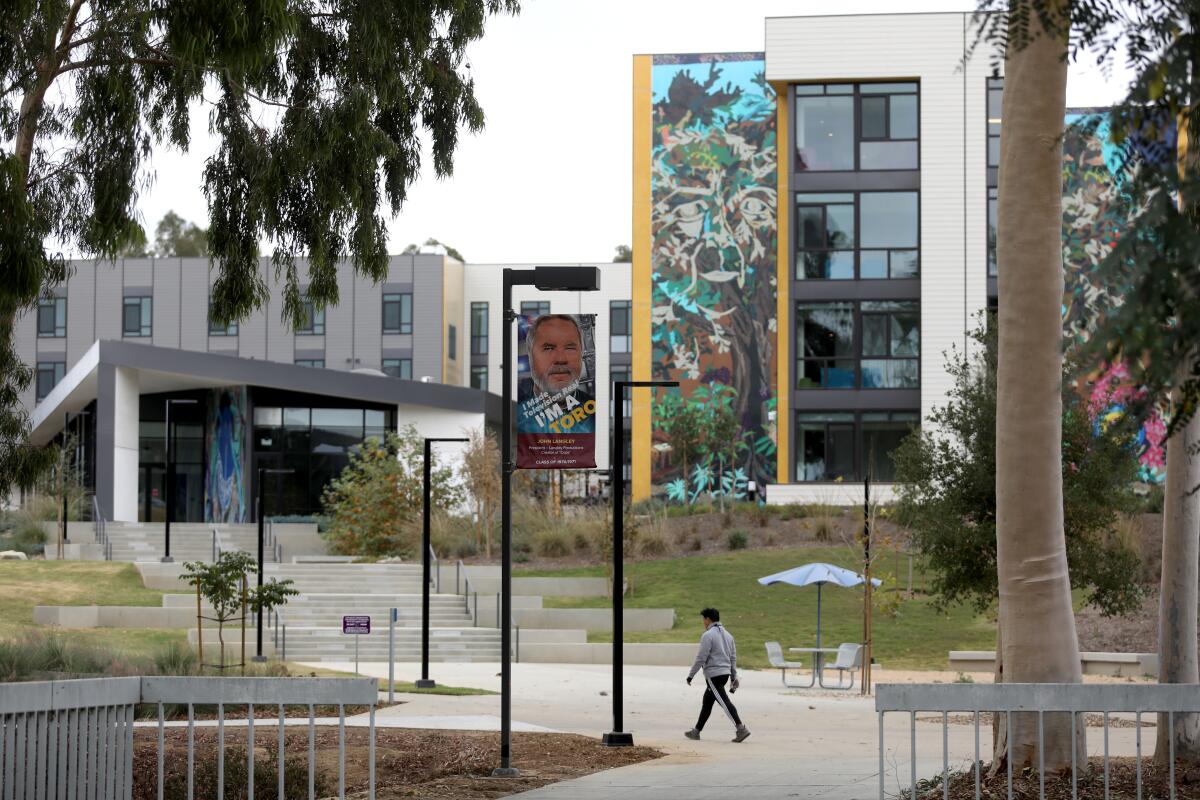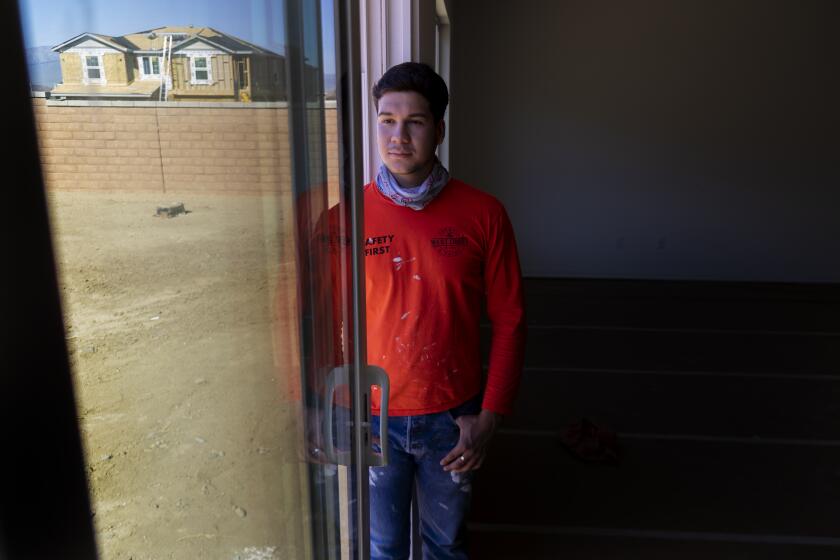Many CSU students see big upsides to online learning. Now, there is a push to expand it

- Share via
In early December, California State University leaders made a bold announcement: All 23 campuses would reopen for in-person classes in fall 2021. But with registration underway for the new academic year, the return is looking anything but normal — and it has become clear the pandemic has altered the future of the nation’s largest four-year university system.
Online options are here to stay.
Throughout the system, in spring surveys, campus discussions and early registration trends, a new realization has emerged among students and staff. At CSU’s largely commuter campuses, many found valuable upsides to virtual learning: greater flexibility in their college-work-life balance, fewer expenses, the power to keep students in college.
“What we learned during the pandemic is that virtual learning provides the opportunity for students to get an education while they’re trying to balance a number of different things in their lives, whether they’re parents or taking care of an elderly parent or working or living in a rural area,” CSU Chancellor Joseph Castro said this week. “What I believe, based on what I’ve heard from students and faculty and staff throughout the CSU, is that we will have more virtual offerings after the pandemic is over than we did before the pandemic.”
Not all students may want to pursue virtual courses, and challenges remain to expand limited pre-pandemic offerings. But a greater blending of instruction could make a long-term difference for students, Castro said.
“I very much want to see the CSU achieve this goal of higher graduation rates and eliminating equity gaps. And I think that we can do this by providing the flexibility. The access is so necessary for our students from all different backgrounds to succeed.”

The changing environment at CSU reflects post-pandemic higher education trends nationally in which students are demanding more online options. And many CSU students bring distinct California challenges to their education, grappling with high housing costs and traffic-clogged commutes to campus while juggling multiple jobs.
About 80% of the system’s 485,550 students receive some form of financial aid and roughly 50% of all undergraduates receive the Pell Grant, according to CSU. The most recent data from 2018 show that of those students on financial aid, more than 24,020 are student parents, according to a UC Davis study. Latino students account for the largest demographic, comprising more than 44% of the CSU student body. About 22% of the total student body is white, nearly 16% are Asian or Pacific Islander and roughly 4% of students are Black.
The nation’s largest four-year university system, among the first to announce an all-virtual instruction plan this fall, says it’s resuming primarily in-person classes and activities at CSU campuses in fall 2021.
Although mainly in-person learning is the overall goal, CSU leaders acknowledge they will need to determine the right proportion of online classes and ensure all students have the technology to access courses. The upcoming semester could offer a barometer for a hybrid model.
Caught between the months-long lead time needed to plan course schedules and the state’s changing reopening directives, no campus is likely to return to a pre-pandemic normal, fully opened for in-person classes —except for the Cal State Maritime Academy. Officials describe fall 2021 as a “transitional semester.”
Cal State Northridge is planning for about a 50% in-person class return, while Cal State Fullerton will see about a 65% to 75% return. San Diego State University plans to reopen in-person learning to about 85% to 90%, whereas Cal State Long Beach will resume in-person classes at about 45%. Up north, Chico State is planning for a 65% return. Some universities, including Cal State L.A., are still in flux and declined to release their in-person reopening percentages.
Cal State Northridge Vice Provost Matthew Cahn said that while the knowledge is “imperfect,” anecdotal evidence and student forums have shown that about half the student body wants to return to campus in the fall, while about half wants to remain virtual. A similar sentiment was shared at Chico State.
“We have this unique opportunity of moving forward, to take the good parts of this year and address the challenges,” said Michal Kurlaender of UC Davis’Policy Analysis for California Education. “If we just go back to business as usual, that would be a missed opportunity to not learn how to utilize lessons from this year and a half.”
Students discovered upsides
Pilar Caceres, 42, is a graduating senior at Cal State Long Beach and the mother of a 5-year-old boy and a 7-year-old girl. Virtual instruction has been challenging at times in a full house, but the flexibility has given her time with her children.
Broader access to a hybrid learning model would mean that students with weighty family responsibilities like Caceres — a double major in child development and family studies and family life education as well the commissioner for the campus’ Pregnant and Parenting Students Club — may no longer have to pit their priorities against each other or leave school behind.
“I think if you have options, it will give you more control of your life,” she said. “If we have that flexibility, it will be easier for us to get the degree.”
Enrollment is at an all-time high for the California State University system. Why?
Before the pandemic, Roshelle Czar, 27, a student at Sacramento State majoring in women’s studies, said she had “hit my breaking point.” While supporting herself financially, she juggled two jobs to make high rent payments, all while carrying a full academic load. After campus shut down and all courses went virtual, Czar moved to Arizona, where she could forgo high rent to live with a friend.
“If this global pandemic wouldn’t have happened, would I have ended up being a college dropout?” Czar said. “I was so drained out and exhausted by the challenges I kept facing.”
She recognizes that virtual learning has its drawbacks, including often shaky Wi-Fi and lack of in-person interaction. But the benefits have outweighed them. She was able to become a certified domestic violence counselor this past year, an achievement that would have been difficult when she struggled to find any extra time in her day. She will graduate in the fall and is planning to finish her requirements from Arizona.
Even students clamoring to return fully to campus life acknowledged that many of their peers deserve broader flexibility.
“I think moving forward for the fall or even just the future, having some sort of dual modality is going to be important,” Maryana Khames, 20, a San Diego State University rising senior and board of trustees student representative. “We’re really excited to go back to in person just as students, but also having some sort of option of having virtual classes.”
The virtual challenge ahead
The emergency pivot to online learning presented deep hardships to many students — issues that must be solved to ensure that online options can benefit all who want them.
It became apparent during the pandemic that technology, and proper access to it, was also a basic need among students, along with food and housing, said Alison Wrynn, CSU associate vice chancellor for academic programs, innovations and faculty development.
A recent California Student Aid Commission-UC Davis report that surveyed tens of thousands of students on financial aid across the CSU, University of California and state’s community college systems in November 2020 revealed inequitable access to internet and laptops, with many students often working outside their homes to access free Wi-Fi. Roughly 62% of respondents said they did not have stable internet access and 44% said they could not access online course material.
“Faculty were teaching in parking lots on campus; students were Zooming in parking lots of McDonald’s or wherever they could find good Wi-Fi,” said Gary Hytrek, a professor of geography at Cal State Long Beach and copresident of the California Faculty Assn. Long Beach chapter, who will be teaching about half his classes online in the upcoming semester. “I think it got easier as we became more familiar with the pitfalls. But there were still problems.”
Face-to-face conversations also play out differently than those through a screen. George Floyd’s death, for example, was a topic that Cal State Fullerton criminal justice professor Monishia “Moe” Miller said she was not comfortable discussing virtually in the event that someone was triggered behind a darkened screen, unbeknownst to her.
Despite the belief that online lessons are often not an equal substitute for in-person classes, she, like other professors, also understands the need for flexibility in the future — albeit with an overhaul.
Campuses throughout the CSU system used federal funding this year to purchase mobile devices and hot spots to assist students’ technological needs, Castro said, and a new initiative is in the works for the fall to ensure that every student has access to a “quality device.”
CSU hasn’t yet released preliminary enrollment figures for the fall, nor have campuses shared stats from delayed registrations. But early estimates show that some online classes have filled up faster than in-person courses, Wrynn said. Officials believe that may in part be due to COVID-19-related safety concerns.
“There’s some courses that I think lend themselves, based on their pedagogy, well to online learning, and there’s others that don’t,” said Jody Cormack, vice provost of academic programs and dean of graduate studies at Cal State Long Beach.
“It’s hard to say what would drive someone to want online learning. While we’re in the middle of a pandemic, I think we must assume it’s people’s concerns about health and safety. But there’s other things too,” she said, pointing out that some may be more comfortable learning at home while others who commute may benefit as well.
“We won’t really understand what a lot of those needs are until we’re outside of the pandemic.”
More to Read
Sign up for Essential California
The most important California stories and recommendations in your inbox every morning.
You may occasionally receive promotional content from the Los Angeles Times.












